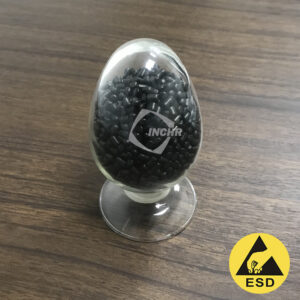What is conductive compound?
Conductive compounds are multiphase composite materials, mainly composed of polymer matrix and various conductive fillers through physical or chemical methods. The purpose is to obtain a certain conductive function and maintain good mechanical properties.
Composition of conductive compound
- Polymer matrix: Common ones include polyethylene (PE), polypropylene (PP), polystyrene (PS), polyvinyl chloride (PVC), acrylonitrile-butadiene-styrene copolymer (ABS), polycarbonate (PC), alloy (PC+ABS), polyoxymethylene (POM), polybutylene terephthalate (PBT), polyamide (PA), polyetheretherketone (PEEK), etc. These polymers have good plasticity, processability, and mechanical properties, providing basic physical properties for conductive compounds.
- Conductive fillers: including carbon black, carbon fiber, graphite fiber, metal powder (such as silver powder, copper powder, aluminum powder, etc.), metal fiber, and carbon nanotubes. The addition of these conductive fillers can make the originally non-conductive polymer matrix conductive. The quality of its conductive performance depends on factors such as the type, shape, size, content, and dispersion degree of the filler in the matrix.

Performance characteristics of conductive compound
- Conductive performance: The conductive performance of conductive compounds is its most important feature. Its surface resistivity and volume resistivity are usually much lower than those of ordinary polymer materials. The strength of the conductive performance can be controlled by adjusting the type and content of conductive fillers according to different application requirements.
- Mechanical properties: Adding an appropriate amount of conductive fillers to the polymer matrix generally does not have a significant impact on the mechanical properties of the material. On the contrary, it may improve the mechanical properties of the material such as strength, hardness, and wear resistance to a certain extent. However, if the content of conductive fillers is too high, it may lead to problems such as decreased toughness and poor processing performance of the material.
- Otherproperties: Conductive compounds may also have good antistatic properties, electromagnetic shielding properties, thermal conductivity, etc. These properties make it have broad application prospects in electronics, electrical, communications, aerospace, and other fields.
Many important applications of conductive compounds in the automotive
Automotive electronic components
Sensors: Various sensors on cars, such as temperature sensors, pressure sensors, position sensors, etc., need to have good conductivity to accurately transmit signals. The conductive compound can be used to manufacture the outer shell or internal conductive parts of the sensor to ensure the stable transmission of sensor signals and improve the accuracy and reliability of the sensor.
Connectors: There are a large number of connectors in automotive electronic systems, which are used to connect different electronic devices and lines. Conductive compounds can be used to manufacture connectors with good conductivity and mechanical strength to ensure stable transmission of signals at the connection parts and withstand vibration and impact during the driving process of the car.
Circuit boards: The electronic control unit (ECU) and instrument panel of the car contain circuit boards. Conductive compounds can be used to make conductive lines and solder joints of circuit boards, provide stable electrical connections, and ensure the normal operation of electronic equipment.

Electrostatic protection
Automotive interior parts: Seats, carpets, instrument panels, and other parts in the interior of the car are prone to static electricity during use, which may cause discomfort to passengers and even cause safety hazards such as fire. The conductive compound can be used to manufacture these interior parts, making them have good conductivity and able to conduct the generated static electricity to the ground in time to eliminate the hazards of static electricity.
Fuel system: During the transportation and storage of fuel, static electricity may cause the fuel to burn and explode. Conductive compounds can be used to manufacture fuel tanks, oil pipes, and other components to improve the anti-static performance of the fuel system and ensure the safe transportation and storage of fuel.
Electromagnetic shielding
On-board electronic equipment: On-board electronic equipment such as radios, navigation systems, and Bluetooth devices in cars are easily interfered with by external electromagnetic signals, affecting their normal operation. Conductive compounds can be used to manufacture the shell or shielding layer of electronic equipment to block the intrusion of external electromagnetic signals and improve the anti-interference ability of electronic equipment.
High-voltage wires and cables: The high-voltage wires and cables of cars generate electromagnetic fields when transmitting current, which may interfere with surrounding electronic equipment. The conductive compound can be used to manufacture the insulation layer or shielding layer of high-voltage wires and cables to reduce the leakage of electromagnetic fields and reduce the impact on surrounding electronic equipment.
Lightweight structural parts
Body parts: Conductive compounds can be combined with fiber-reinforced materials to produce body parts with good conductivity and mechanical strength, such as body panels, bumpers, doors, etc. These parts can not only reduce the weight of the car and reduce fuel consumption, but also meet the safety performance requirements of the car.
Battery shell: With the development of electric vehicles, the demand for battery shells is increasing. The conductive compound can be used to manufacture battery shells, which can not only provide good conductivity, and facilitate battery charging and discharging management, but also ensure the strength and safety of the battery shell.
Power system
Motor parts: The motor of an electric vehicle requires efficient conductive compounds to improve its performance. Conductive composites can be used to manufacture motor stators, rotors, brushes, and other parts to reduce resistance and improve the efficiency and power density of the motor.
Fuel cell parts: Fuel cells are one of the future development directions of automobiles, and the fuel cell membrane electrode assembly needs to have good conductivity. Conductive compounds can be used to manufacture the conductive layer of the membrane electrodeassembly to improve the performance and reliability of the fuelcell.




